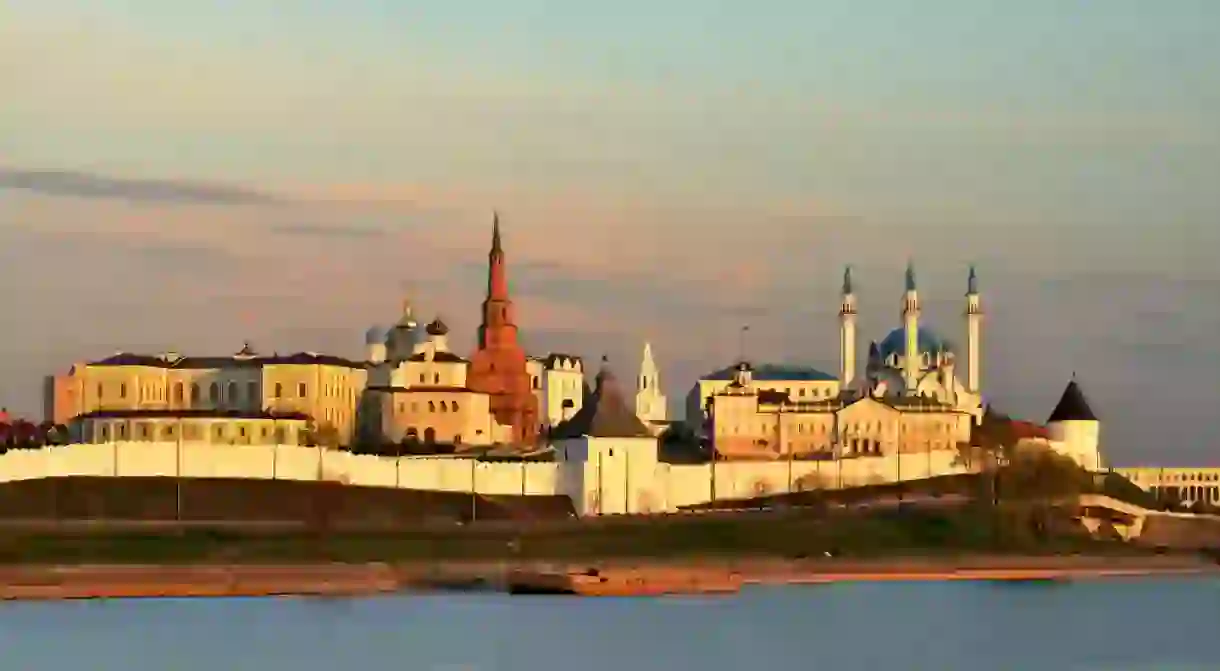The Ultimate Guide to Russia’s Kremlins

The Moscow Kremlin is probably the first image to pop into your mind when someone brings up Russia. However, there are 11 more fortresses scattered all over the world’s largest territory. Despite their respectable age of several centuries, they are in surprisingly good shape and worth a visit.
Astrakhan Kremlin
The southernmost Kremlin in Russia took almost 40 years to build. Finished in 1620, its walls, stretching for 1,487 meters (4,879 feet), were originally topped with eight towers, seven of which still stand. Apart from the breathtaking views from the observation deck, you can admire the Kremlin’s spectacular cathedrals—Troitsky and Uspensky—and visit its ethnographic museum.
Astrakhan, Kremlin, 2 V. Trediakovskogo Street, Astrakhan, Russia, +7 851 239-48-33

Kazan Kremlin
Kazan Kremlin is a unique blend of architectural styles, where East meets West to create something incredibly beautiful. Built 450 years ago, the blue-domed Annunciation Cathedral is the oldest construction on the premises of the Kremlin, and the newest one is the Qolşärif Mosque, reconstructed in 2005 for the celebrations of Kazan’s Millennium.
Kazan Kremlin, Kazan, Tatarstan, Russia, +7 843 567-80-73

Kolomna Kremlin
The Kremlin in Kolomna is considered to be a younger brother of the one in Moscow: there are a lot of similar architectural details that no other Kremlins have. Experts believe that the same person—Italian architect Aloisio da Milano—created the two citadels. Less famous than its older brother, the Kolomna Kremlin was conceived in 1525 to secure Moscow’s southern borders. Here, you’ll get a chance to put on medieval armor, try your hand at shooting an ancient bow and arrow and visit the Dormition Cathedral, commissioned by Prince Dmitry Donskoy.
Kolomna Kremlin, 182 Oktyabrskoy Revolyutsii Street, Kolomna, Moscow Region, Russia, +7 496 612-16-62

Zaraysk Kremlin
The Zaraysk Kremlin, built in 1531, is the best-preserved citadel in the Moscow region. Despite being 10 times smaller than the Kolomna Kremlin, it has witnessed and survived some history-changing battles. In 1608, during a highly unstable period of Russia’s history known as the Time of Troubles, Prince Dmitry Pozharsky built a volunteer army in the Zaraysk Kremlin to liberate Moscow from Polish invaders.
Zaraysk, Kremlin, 2 Revolyutsii, Zaraysk, Moscow Region, Russia, +7 496 66-730-72

Novgorod Kremlin
While the original fortress from the middle of the 10th century no longer stands, the stone walls of one of Russia’s oldest citadels were erected in the 15th century. This Kremlin is home to the Cathedral of St. Sofia—the oldest one in Russia. Commissioned in 1045, the Cathedral is particularly famous for the Magdeburg Gates and “the Mother of God of the Sign” icon, which legend says miraculously saved Novgorod in 1169.
Novgorod, Kremlin 11, Veliky Novgorod, Novgorod Region, Russia, +7 816 277-36-08

Nizhny Novgorod Kremlin
Built in 1515, the stone Kremlin in Nizhny Novgorod replaced the wooden fortress, which had been protecting the city since 1221. The Kremlin features dramatic elevation changes, which makes it one of the most sophisticated constructions of its time. The word is that somewhere in the Kremlin’s dungeons, Ivan the Terrible hid his library, which his grandmother Sophia Palaiologina had brought from Byzantium.
Nizhny Novgorod, Kremlin, Minin and Pozharsky Square, Nizhnij Novgorod, Nizhegorodskaya Region, Russia, +7 831 422-10-80

Pskov Kremlin
Having endured 26 sieges, Pskov Kremlin, or Pskov Krom, is also considered one of the oldest fortresses in Russia—the first stone constructions here were built in the 13th century. The Trinity Cathedral in its center is known to have the oldest functioning bells in the country.
Pskov Kremlin, Pskov, Pskov Region, Russia, +7 811 272-45-74

Rostov Kremlin
What started as an archiereus residence in the 17th century is now a visually arresting museum-reserve with five churches, the Dormition Cathedral, and civil buildings—all surrounded by monumental fortress walls. Be sure to stop by the Kremlin’s 17th-century bell-cot—one of the most celebrated in Russia.
Rostov Kremlin, Rostov, Yaroslavskaya Region, Russia, +7 485 366-15-02

Tula Kremlin
Built in 1514, the Tula Kremlin is known for its unique location: unlike most of Russia’s Kremlins, which usually stand on a hilltop, this one sits on the Upa River lowlands. Today, the Tula Kremlin is home to the 18th-century Assumption Cathedral, 19th-century Epiphany Cathedral, and a century-old shopping arcade.
Tula Kremlin, 2 Mendeleyevskaya Street, Tula, Tula Region, Russia, +7 487 231-25-38

Tobolsk Kremlin
The only stone Kremlin in Siberia, this white-walled masterpiece was constructed between the 17th and 18th centuries, which explains the combination of Baroque and Renaissance elements in its architecture. The Tobolsk Kremlin comprises 32 constructions, including the magnificent St. Sophia Assumption Cathedral, Gostiny Dvor, and several museums. A photograph of the Tobolsk Kremlin, taken by Russia’s prime minister Dmitry Medvedev, was sold at a charity auction for $1.75 million, which makes it one of the world’s most expensive photographs.

Ryazan Kremlin
Ryazan Kremlin encompasses 18 historic monuments, built between the 11th and 19th centuries. One of the Kremlin’s eight churches, the 17th-century Dormition Cathedral, is the centerpiece of the fortress. The oldest building is the 15th-century Nativity of Christ, while the largest civic construction is the 17th-century Oleg’s palace.
Ryazan Kremlin, 15, Ryazan, Ryazanskaya Region, Russia, +7 491 227-60-66














